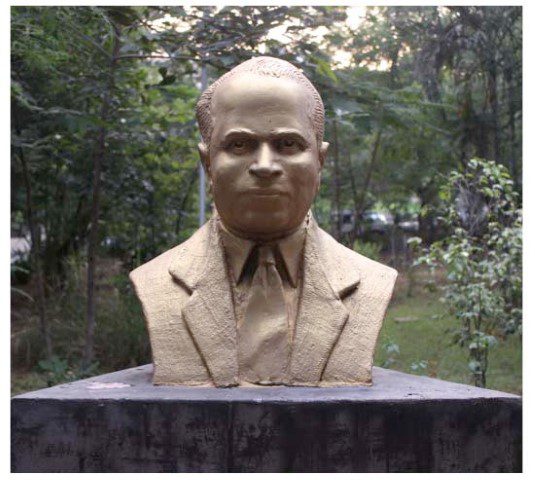Beerelli Seshi
La Jolla, California, United States
Marshall Lichtman
Rochester, New York, United States
 |
|
Yellapragada SubbaRow’s bust in the garden of the Nizam’s Institute of Medical Sciences, Hyderabad, India. It appears somewhat neglected, reflecting the fading memory of his many important, indeed monumental, contributions to human biology and medicine. SubbaRow was quick to share his successes with his team. He was known for his acts of generosity. As SubbaRow said, “The victories of science are rarely won single handed. No one man should get the (entire) credit.” Kindly photographed for this essay by Beerelli Laxma Reddy |
There existed only one SubbaRow: Yellapragada Subba Rao (1895–1948).1-6 The name Subba Rao is as ubiquitous in Andhra Pradesh, the Telugu-speaking part of India, as John Smith is in North America, so SubbaRow creatively modified his name. His creativity was more evident in his trailblazing discoveries. Isaac Newton worked on optics while “sleeping” on other topics such as mechanics, enabling him to leave his mark forever on all branches of physics. Yellapragada SubbaRow likewise made lasting contributions to biochemistry, pharmacology, microbiology, oncology, and nutritional science.
SubbaRow did not receive a Nobel Prize, but his discoveries entitle him to be called the father of targeted cancer chemotherapy. He worked initially in the laboratory of Cyrus Fiske at Harvard Medical School, and later as Director of Research at the Lederle Laboratories. He first invented a method for measuring phosphorus, the Fiske-SubbaRow method,6 which led him to discover two critically important phosphate-containing molecules, phosphocreatine and adenosine triphosphate (ATP). As of October 2013 his paper had been cited 22,547 times. ATP functions as the principal source of energy for metabolic processes. Phosphocreatine provides energy to the muscle and brain during periods of exaggerated need. Motivated by the death of two brothers from tropical sprue, SubbaRow led the research that synthesized folic acid, essential for the formation of DNA. This led him to conceive and develop the folic acid analogs aminopterin and amethopterin (methotrexate), which act as inhibitors of DNA synthesis in rapidly proliferating leukemic cells and resulted in the first remissions of childhood acute leukemia. SubbaRow also contributed to the discovery of vitamin B12 – by investigating liver extracts as cure for pernicious anemia. The parasitic disease, filariasis, rampant in SubbaRow’s birthplace in India, causes inflammation, blocks lymphatic flow, and produces disfiguring elephant-like legs. He developed diethylcarbamazine (Hetrazan), a highly effective agent against filariasis. SubbaRow also directed the research that discovered the first broad-spectrum antibiotic, the first tetracycline, chlortetracycline, fittingly called Aureomycin, auguring the golden era of antibiosis. These were not serendipitous discoveries, but the fruits of a brilliant, insightful mind.
SubbaRow was born into a Brahmin family that cherished scholarly traditions and ideals. He grew up encircled by Telugu intellectuals and poets that set the highest standards of achievement at a time (in the 1910s) when basic education was inaccessible to the vast majority of the populace. SubbaRow’s opportunity for education is even more remarkable when one considers that as late as the 1960s children from villages had to walk ten miles to school. SubbaRow also witnessed his country’s brightest individuals joining the freedom movement and sacrificing their lives. Such backgrounds and circumstances compelled him to seek Paramartha (the highest truth) – not necessarily Fame – explaining the inseparable duality of a brilliant scientist and self-effacing man.3 We ask, what fame4,5 was there to be courted for a man who tried to escape to Kashi, the holy religious city on the river Ganga, and subsequently was schooled at the Ramakrishna Mission (founded by Swami Vivekananda, the man known for his historic speech on religious unity and tolerance at the first Parliament of World’s Religions held in Chicago, Illinois, in 1893)? Fashioned by such experiences, SubbaRow set sail in 1923 to Cambridge, Massachusetts, at a time when few Indians were seeking to or were even allowed to enter the United States. He was a pioneer for whom no barrier was insurmountable. Did he think that he attained Paramartha? We doubt it, judging by his poignant statement about his epochal scientific discoveries “Science simply prolongs life, but religion deepens it.” SubbaRow was among the greatest scientists of all time, and importantly also a humanist.
References
- http://www.ysubbarow.info/Archive/home.php
- http://www.ysubbarow.info
- S. P. K. Gupta , S. Bansal , V. Ramesh. Remembering Yellapragada SubbaRow. International Journal of Dermatology 2013 Jul; 52(7):882-886.
- S. P. K. Gupta. The dilemma of a fame-hunter, Reflections on Yellapragada SubbaRow centenary. Current Science 1995 Jan; 68 (10): 110-113.
- P. M. Bhargava. Dr. Yellapragada SubbaRow (1895-1948) He Transformed Science; Changed Lives. Journal, Indian Academy of Clinical Medicine 2001 Jan–June; 2(1 & 2): 96-100.
- C.H. Fiske, Y. SubbaRow. The colorimetric determination of phosphorus. Journal of Biological Chemistry 1925 Dec; 66 (2): 375-400.
BEERELLI SESHI, MD, is a physician and biomedical research investigator. He graduated from Osmania Medical College, Hyderabad, India. He completed residency in Pathology at Yale University. Seshi grew up learning about and idolizing SubbaRow, after he witnessed SubbaRow’s photo in his anatomy professor’s office, with inscription, “Science simply prolongs life, but religion deepens it.” His fields of accomplishments include hematopathology, stem cell biology, and functional proteomics. He has held professorships at University of Rochester, University of South Florida, and University of California, Los Angeles. He has recently completed serving as a Clinical Fellow in Hematopathology at Scripps Clinic and Scripps Green Hospital.
MARSHALL A . LICHTMAN, MD, is a physician and biomedical research investigator. He is Professor of Medicine (Hematology) and Biochemistry and Biophysics at the University of Rochester School of Medicine where he has spent his entire career. He has served as President of the American Society of Hematology and on the Board of Governors of the American Red Cross. He was Dean of the University of Rochester School of Medicine and Dentistry from January 1990 to December 1995.

Leave a Reply